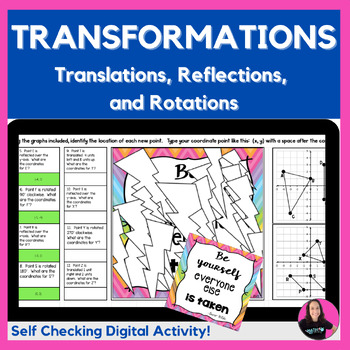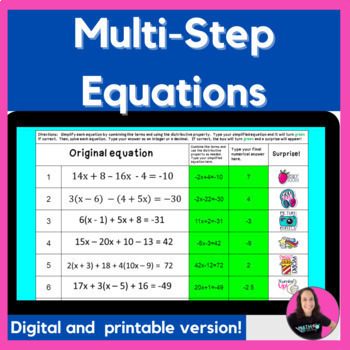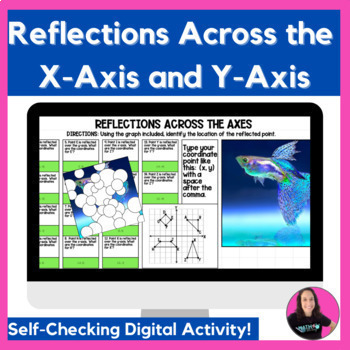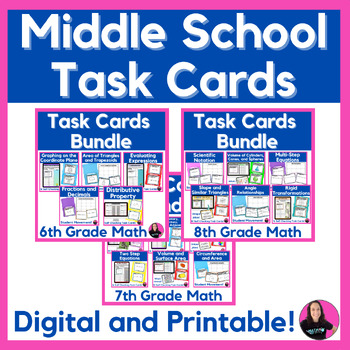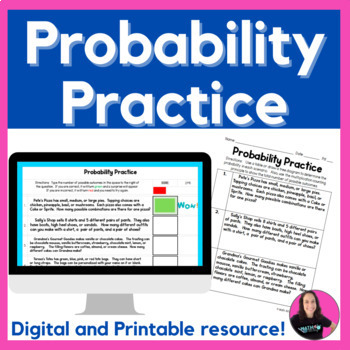Picture this: your students are up out of their seats, buzzing with energy, working together to solve math problems, and here is the most exciting part…They are actually excited about math class. Sounds too good to be true? Not when you introduce a math scavenger hunt worksheet activity! Yes, I know you’re a middle school teacher. Your students aren’t in first grade math class. But I promise 6th grade math and beyond can enjoy a good scavenger hunt just as much as first and second grade!
What Are Math Scavenger Hunts?
A math scavenger hunt combines problem-solving with movement, collaboration, and a touch of adventure. Students solve a math problem on a task card or worksheet and then use the correct answer to find the next problem in a different location in the classroom (or beyond). It’s like an academic treasure hunt, where solving problems unlocks the next step. This type of activity works for a wide range of math concepts, from identifying right angles in 4th grade math to reviewing fractions in 7th grade or even tackling algebra in middle school. They’re flexible, fun, and effective.
When Do I Have Time for Scavenger Hunts?
Let’s be real: time is always tight in a math class. Scavenger hunts, however, are surprisingly adaptable.
- They’re perfect for review days, giving students an exciting way to revisit concepts before a test.
- If you have early finishers in your class, scavenger hunts can keep them busy and engaged while others catch up.
- They’re also ideal for independent work, where students work at their own pace in small groups.
How to Set Up a Math Scavenger Hunt
Setting up a scavenger hunt isn’t as daunting as it may seem. Start by choosing a topic that fits your lesson, whether it’s reviewing a math principle or practicing a new skill.
- Design a set of task cards, ensuring each one presents a math problem that leads to the correct answer and the clue for the next problem.
- Arrange the cards in different locations around your classroom, hallway, or even outside if the weather permits.
- To add variety, you can include word problems, diagrams, and even QR codes for a modern twist.
- Provide students with a recording sheet so they can track their answers and progress.
- Lastly, test the hunt yourself to make sure the problems flow seamlessly from the first card to the last card.
What Does a Math Scavenger Hunt Worksheet Look Like?
A typical worksheet for a scavenger hunt includes several key components. It begins with clear instructions to guide students through the activity. The task cards contain math problems paired with clues for finding the next problem. A student recording sheet is included to help students track their answers and verify their work. Some scavenger hunts also include an activity sheet with additional problems or extensions for students who finish early.
Why Are Scavenger Hunts So Effective?
Scavenger hunts are not only fun but also highly effective at reinforcing mathematical concepts. They encourage active learning by getting students out of their seats and moving around. The format offers immediate feedback, as students must solve each problem correctly to proceed.
Math scavenger hunts also promote collaboration in small groups or can be used for independent work, depending on your classroom setup. What’s more, they’re versatile enough to work for all grade levels, from 1st grade to high school students.
Math Scavenger Hunt Ideas for Middle School
If you’re looking to challenge middle school students with engaging and relevant math scavenger hunts, here are some ideas tailored to their level:
Linear Equations and Slope
Create task cards with problems requiring students to calculate the slope of a line, write equations in slope-intercept form, or solve for variables in linear equations. Hide the cards around the classroom, and each correct answer leads them to the next card.
Proportions and Ratios
Design a scavenger hunt where students solve real-world problems involving ratios, proportions, and unit rates. For example, they might calculate how many items can be purchased within a budget or determine the correct ratio of ingredients for a recipe.
 |
| Click Here for the 6th Grade Scavenger Hunts |
Pythagorean Theorem Applications
Take students on a hunt where they solve problems involving the Pythagorean Theorem. They could calculate the distance between two points on a grid or find missing side lengths of right triangles.
Geometry Transformations
Set up a scavenger hunt focusing on translations, reflections, rotations, and dilations. Each card could include a graph with a transformation problem, and the correct answer guides them to the next clue.
Data Analysis and Statistics
Use a scavenger hunt to reinforce skills like calculating mean, median, mode, and range. Include problems that require interpreting graphs, such as bar graphs or scatter plots, to make it more interactive.
 |
| Click Here for the 7th Grade Scavenger Hunts |
Probability Challenges
Design a hunt that involves solving probability problems. Students might calculate the likelihood of certain outcomes, create sample spaces, or work with compound probability scenarios.
Algebraic Expressions and Equations
Create task cards all about expressions and equations. Students simplify expressions, solve multi-step equations, or factor polynomials. Each card builds on the previous one, leading students deeper into algebra concepts.
Coordinate Plane Explorations
Have students solve coordinate plane problems that require plotting points, finding distances between points, or identifying quadrants. Add a scavenger element where their answers reveal the location of the next task card.
 |
| Click Here for the 8th Grade Scavenger Hunts |
Surface Area and Volume
Set up a hunt where students calculate the surface area or volume of 3D shapes like cylinders, cones, and prisms. Each card could include a diagram and measurements, leading to the next clue.
Real-World Math Applications
Design a scavenger hunt that uses practical math problems involving shopping, travel, or sports. For example, students might calculate discounts, compare rates, or analyze sports statistics.
 |
| Click Here for the Middle School Math Scavenger Hunts |
These middle school scavenger hunt ideas are sure to keep your students engaged while reinforcing essential math skills. Adjust the complexity of the problems to match your student's needs, and watch their enthusiasm for math grow!
Math scavenger hunts bring excitement back to math class. Whether you’re teaching 6th grade math, creating an engaging activity for small groups, or reviewing with whole groups, these hunts are a hit. Have you tried a math scavenger hunt activity? Let me know your favorite themes or how you’ve adapted them for your students!





